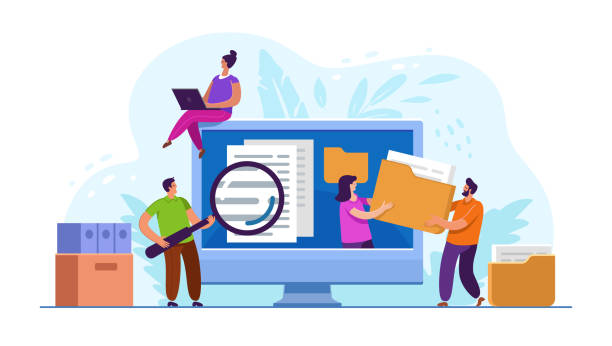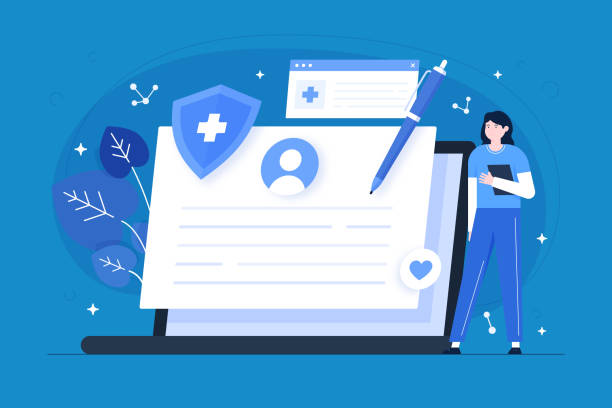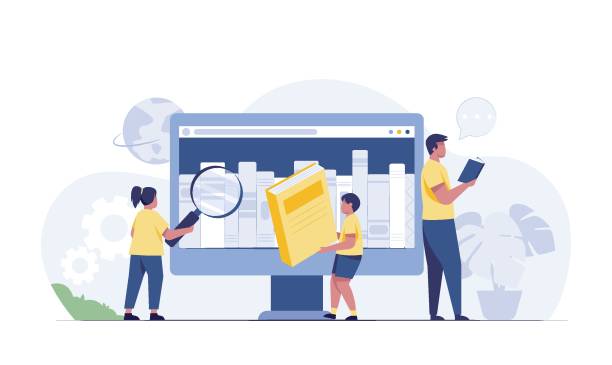Introduction to the Importance of Security in Web Design

In today’s digital world, where businesses are increasingly moving online, the importance of secure website design has become more evident than ever.
A website is not just a virtual storefront; it’s a place for exchanging sensitive information, conducting financial transactions, and communicating with customers.
Any security vulnerability can lead to loss of customer data, privacy breaches, malicious cyberattacks, and ultimately, damage to business reputation.
Therefore, #web_security and #data_protection must be prioritized from the very early stages of #website_design to establish a strong foundation for online activities.
The main goal of secure website design is to create a digital environment where users can operate with confidence.
This includes protecting personal data, financial information, and any sensitive interactions between the user and the server.
Without this protective layer, risks such as information theft, #phishing_attacks, and malicious code injection increase significantly.
Imagine an online store revealing its customers’ credit card information due to a security weakness; this could have irreparable consequences for the business’s reputation and survival.
Therefore, a proactive approach to security is not just an option, but a vital necessity.
This approach means identifying and rectifying potential weaknesses before attackers can exploit them and cause irreparable damage.
The increase in cyberattacks in recent years has highlighted the necessity for comprehensive and continuous approaches in secure website design.
Hackers are constantly devising new methods of infiltration, which requires web developers and administrators to continuously update their knowledge in security and equip themselves with the latest defensive methods.
Investing in security is, literally, an investment in the future and sustainability of your online business.
Neglecting this aspect can lead to exorbitant costs, including heavy legal penalties, loss of customer trust, and a significant reduction in revenue.
Therefore, a deep understanding of threats and the implementation of effective solutions are the backbone of any successful secure website design project and guarantee the continuity of online activities in a high-risk environment.
Did you know that your company’s website is the first point of contact for 75% of potential customers?
Your website is the face of your brand. With **Rasaweb**’s corporate website design services, build an online presence that earns customer trust.
✅ Create a professional and lasting image for your brand
✅ Attract target customers and increase online credibility
⚡ Get free consultation from **Rasaweb** experts!
Understanding the Most Common Web Security Threats

To be able to engage in secure website design, we must first become familiar with the common types of security threats that websites face.
Understanding these threats is the first step in countering them and implementing effective defensive solutions.
One of the most prevalent attacks is #SQL_injection, in which an attacker injects malicious SQL code through website input fields to gain access to or modify the database.
This type of attack can lead to the theft of sensitive information, data deletion, and even full control over the server.
#Web_vulnerabilities like SQL Injection and Cross-Site Scripting (XSS) should always be considered.
Another increasingly dangerous attack is #XSS_attacks or Cross-Site Scripting.
In this type of attack, the attacker injects malicious script code into web pages viewable by other users.
This code can steal user cookies, control their sessions, or even phish sensitive information.
XSS attacks can directly harm end-users and erode their trust in the website.
Furthermore, #DDoS or Distributed Denial of Service attacks are also a major concern.
In these attacks, attackers send a huge volume of fake traffic, making the website server unavailable and preventing legitimate users from accessing it.
These attacks can lead to lost revenue and reputational damage.
Other threats include #Session_Hijacking, #Phishing, and the use of #vulnerable_components.
Session hijacking occurs when an attacker gains access to a user’s Session ID and impersonates them.
Phishing is an attempt to trick users into revealing sensitive information through fake pages.
Also, using web libraries, plugins, or frameworks with known vulnerabilities can provide an easy entry point for attackers.
Teams involved in secure website design should regularly review the #OWASP_vulnerabilities list and implement best practices to prevent these attacks.
Understanding these threats is the crucial first step in building a robust and reliable online platform.
Key Principles of Secure Design from the Start

To ensure secure website design, key principles must be followed from the earliest stages of product development.
The “Security by Design” approach means incorporating security considerations into every stage of the software development lifecycle, rather than adding security as an extra layer at the end.
One of the most important principles is the Principle of Least Privilege; this means that every user, service, or application should only have the minimum necessary access rights to perform their tasks.
This significantly reduces the scope of potential attacks.
Secure coding and #input_validation are also of high importance.
All user inputs must be carefully validated and filtered to prevent injection attacks such as SQL Injection and XSS.
Using Prepared Statements in database interactions, as well as filtering and escaping all inputs sent to the browser, are essential measures.
Furthermore, strong encryption should be used for all sensitive data, both in transit and at rest.
Implementing the HTTPS protocol with a valid SSL/TLS certificate is a fundamental requirement for encrypting communication between the user and the server.
System architecture also plays a significant role in secure website design.
Separating different application layers (such as the web layer, business logic layer, and data layer) and restricting communication between them can prevent attacks from spreading if one layer is breached.
Furthermore, using strong #session_management and #authentication mechanisms for users, such as using secure tokens and not storing sensitive information in cookies or browser localStorage, is crucial.
Finally, regular code reviews by other developers and the use of static and dynamic code analysis tools can significantly help in identifying vulnerabilities in the early stages.
Table 1: Checklist of Basic Principles for Secure Web Design
| Security Principle | Explanation | Importance |
|---|---|---|
| Principle of Least Privilege | Each entity has only the minimum necessary access rights. | Reduces attack surface in case of a breach. |
| Input Validation | Validating and filtering all user inputs. | Prevents injection attacks (SQLi, XSS). |
| Secure by Default | Secure and strong default settings. | Reduces risk of configuration errors. |
| HTTPS Everywhere | Use of SSL/TLS for encrypting all communications. | Protects data in transit. |
| Error Handling | Proper error handling without revealing sensitive information. | Prevents information disclosure attacks. |
The Vital Role of Security Protocols on the Web

Within the framework of secure website design, security protocols play a vital and undeniable role.
The most prominent and important of these protocols is HTTPS, which is considered the secure version of the HTTP protocol.
The use of HTTPS means encrypting all data exchanged between the user’s browser and the website server.
This encryption occurs through the SSL/TLS (Secure Sockets Layer / Transport Layer Security) layers.
With HTTPS, any sensitive information such as usernames, passwords, credit card details, and users’ personal data are protected against eavesdropping, tampering, and forgery.
The importance of HTTPS goes beyond mere encryption.
Using this protocol not only builds user trust but also positively impacts website SEO (Search Engine Optimization); search engines like Google prefer HTTPS-enabled websites in their rankings.
To implement HTTPS, you need a valid #SSL/TLS_certificate from a Certificate Authority (CA).
This certificate verifies your website’s identity and provides the necessary public keys for encryption.
Without HTTPS, data is transmitted in plaintext and can be easily read by any attacker who can eavesdrop on network traffic.
In addition to HTTPS, other protocols like #HSTS (HTTP Strict Transport Security) can also enhance security.
HSTS instructs browsers to always use HTTPS for communication with your website, even if the user mistakenly types the address with HTTP.
This prevents #SSL_Stripping attacks, where an attacker tries to downgrade HTTPS traffic to HTTP.
Finally, proper web server configuration, ensuring the use of new and secure SSL/TLS versions (such as TLS 1.2 or TLS 1.3), and disabling old and vulnerable versions, are also important components of secure website design at the protocol level.
Failure to comply with these can become a major weakness for a website, even if other security aspects are well maintained.
Does your current corporate website present a worthy image of your brand and attract new customers?
If not, turn this challenge into an opportunity with Rasaweb’s professional corporate website design services.
✅ Significantly improves your brand’s credibility and image.
✅ Paves the way for attracting new leads and customers.
⚡ For a free and specialized consultation, contact Rasaweb now!
Database Security and Input Management

The beating heart of every website is its #database, which stores all user information, products, transactions, and site content.
Therefore, #database_security is of paramount importance in secure website design.
One of the biggest threats is #SQL_injection attacks, which were mentioned earlier.
To counter these attacks, all user inputs, without exception, must be carefully validated and filtered.
Using Prepared Statements or Parameterized Queries for all database interactions is the best defense against SQL Injection.
This method ensures that user inputs are processed as data, not as part of the SQL code.
In addition to input validation, other principles are also vital for #database_security.
Firstly, #encryption_of_sensitive_data must be used in the database.
Information such as passwords (which should be hashed and salted), credit card numbers, and other personal information should not be stored in plaintext.
Strong hashing algorithms like Bcrypt or Argon2 are recommended for storing passwords.
Secondly, the #principle_of_least_privilege must also be applied at the database level.
Any application or user accessing the database should only have the minimum necessary permissions to perform their tasks.
For example, a web application that only needs to read and write information should not have permission to delete tables.
Thirdly, #secure_database_server_configuration is crucial.
Default ports should be changed, firewalls should be correctly configured, and remote access to the database should be restricted.
Furthermore, database management software with the latest security patches should be used, and regular database backups should be performed.
#Continuous_monitoring of database activities to identify suspicious patterns and intrusion attempts is also essential.
Failure to comply with these measures can turn your website into an easy target for attackers and severely damage the credibility of your website security.
The Importance of Continuous Security Updates and Maintenance

One of the often-overlooked aspects in secure website design is #continuous_security_maintenance_and_updates.
Even if a website has been designed from the outset with all security principles in mind, without regular maintenance, it will quickly become vulnerable to new threats.
Attackers and security researchers constantly discover new vulnerabilities in various software, including Content Management Systems (CMS) like WordPress, Joomla, and Drupal, programming libraries, plugins, themes, and even server operating systems.
#Security_patches and updates are released precisely to address these weaknesses.
Delaying the installation of these updates means leaving the door open for attackers who exploit publicly disclosed vulnerabilities (CVEs).
For example, many widespread cyberattacks have occurred due to the use of outdated and unpatched software.
Therefore, a regular and automated #update_strategy for all website components, including the CMS core, plugins, themes, and even PHP, MySQL, or other language and database versions, is essential.
In addition to software updates, #security_maintenance includes other aspects as well.
#Regular_backups of all website data and code allow you to quickly restore the website in case of an attack or data loss.
#Active_monitoring for suspicious activities, such as failed login attempts, unauthorized file changes, or unusual server resource consumption, can provide early warnings about an imminent or ongoing attack.
Furthermore, reviewing and removing unnecessary plugins and themes that could create security vulnerabilities are important maintenance tasks.
Finally, continuous training for the website development and management team on best security practices and the latest threats complements all technical measures towards #sustainable_website_security.
This is an ongoing process that must be diligently pursued.
The Role of Firewalls and Intrusion Detection Systems

Within the comprehensive framework of secure website design, the use of defensive tools and systems at the network and application level is of paramount importance.
#Firewalls are considered the first line of defense against cyberattacks.
A firewall filters incoming and outgoing network traffic based on a set of predefined rules.
This helps prevent unauthorized access and block malicious traffic, such as port scans or known intrusion attempts.
Beyond traditional firewalls, Web Application Firewalls (WAF) are specifically designed to protect web applications against attacks at Layer 7 of the OSI model.
WAFs can detect and block attacks such as SQL Injection, XSS, Brute Force attacks, and other web-based threats.
They monitor HTTP/HTTPS traffic and analyze its patterns to identify suspicious activities and stop them before they reach the website server.
The use of a WAF is particularly essential for websites that handle sensitive information or financial transactions.
#Intrusion_Detection_Systems (IDS) and #Intrusion_Prevention_Systems (IPS) are also crucial tools for #network_security and #website_security.
IDSs monitor network traffic and/or system events to identify suspicious activities or security policy violations, and they issue alerts upon detection.
IPSs go a step further and, in addition to detection, also have the ability to prevent attacks.
They can automatically block suspicious connections or eliminate malicious traffic.
Implementing a combination of firewalls, WAF, and IDS/IPS creates a multi-layered defense that significantly increases the website’s #resilience against attacks and greatly helps ensure #sustainable_website_security.
Table 2: Comparison of Web Defense Tools
| Tool | Focus | Capability | Main Advantage |
|---|---|---|---|
| Firewall | Network Layer | Filters traffic based on IP, port | First line of defense, basic access control |
| WAF | Application Layer | Protection against SQLi, XSS, Layer 7 DDoS | Specialized protection against web vulnerabilities |
| IDS | Network and system monitoring | Detection of suspicious activities and alerts | Awareness of security status |
| IPS | Active monitoring and prevention | Automatic blocking of detected attacks | Real-time intrusion prevention |
Penetration Testing and Vulnerability Assessment

Up to this point, we’ve discussed the defensive aspects of secure website design, but how can we ensure the effectiveness of these measures? The answer lies in #Offensive_Security approaches: #Penetration_Testing and #Vulnerability_Assessment.
These processes allow security teams to think like attackers and discover and resolve potential system weaknesses before hackers find them.
Can we truly trust our website’s security without subjecting it to real-world tests?
#Vulnerability_scanning involves using automated tools to identify known weaknesses in systems and applications.
These tools can quickly identify a large list of potential vulnerabilities in code, server configuration, and libraries used.
While vulnerability scans are useful and should be performed regularly, they only provide an initial overview and may overlook more complex or logical vulnerabilities.
In contrast, #penetration_testing is a more comprehensive and manual approach performed by security professionals (ethical hackers).
The goal of a pentest is to simulate a real attack on a website to identify vulnerabilities that automated tools might not be able to discover.
This includes attempting to exploit discovered weaknesses, examining the application’s business logic, and identifying attack chains that could lead to successful infiltration.
A pentest report provides detailed information about identified vulnerabilities, their risk level, and remedial solutions.
Regularly performing pentests, especially after major changes to the code or infrastructure, is crucial for maintaining a high level of security.
These processes not only help to #strengthen_website_security but also provide valuable insight into the system’s #actual_security_posture and help teams continuously improve their website security strategies.
Are you dissatisfied with the low conversion rate of visitors to customers on your e-commerce site?
Solve this problem once and for all with professional e-commerce website design by Rasaweb!
✅ Increase visitor-to-customer conversion rate
✅ Create an excellent user experience and build customer trust
⚡ Get free consultation
Strong Password Management and Authentication

One of the common weaknesses in many online systems, especially in the field of secure website design, is #weak_password_management and insufficient #authentication mechanisms.
Users often tend to use simple, guessable, or repeated passwords, which makes them vulnerable to attacks like #Brute_Force and #Dictionary_attacks.
Therefore, websites should compel users to use #strong and complex passwords.
This includes minimum length, a combination of uppercase and lowercase letters, numbers, and special characters.
In addition to password complexity requirements, implementing #Rate_Limiting mechanisms to prevent Brute Force attacks is essential.
After a few failed attempts, the system should lock the user account for a specific period or require a CAPTCHA.
But most importantly, websites should offer or even mandate #Multi-Factor_Authentication (MFA).
MFA provides an additional layer of security, ensuring that even if a user’s password is stolen, their account remains secure.
This typically involves something the user knows (password), something the user has (like a smartphone to receive a one-time code), or something the user is (like a fingerprint or facial recognition).
For website administrators and developers, #admin_panel_security is of particular importance.
Default or weak passwords should not be used for admin panel access, and MFA should be enabled for all administrative accounts.
Also, it is advisable to change the URL of the admin panel to protect against automated attacks and bot scanners.
Educating users about the importance of strong passwords and the dangers of phishing is also a crucial part of a comprehensive #user_security strategy.
Finally, storing passwords in the database should be done using strong hashing and unique salts to prevent Rainbow Table attacks and ensure that user passwords are not revealed even if the database is breached.
The Future of Secure Website Design and Upcoming Challenges

With the rapid advancement of technology and the evolution of cyber threats, the #future_of_secure_website_design will also undergo continuous changes.
New challenges are emerging that require innovative solutions.
One of the most important of these challenges is the rise of #more_advanced_attacks that use Artificial Intelligence (AI) and Machine Learning (ML) to identify vulnerabilities and bypass defensive mechanisms.
This necessitates that web security professionals also utilize these technologies for defense and prevention.
Artificial Intelligence and Machine Learning can play a significant role in #detecting_emerging_threats, analyzing user behavior to identify anomalies, and automating responses to attacks.
We may see security systems that dynamically and in real-time adapt themselves to changing attack patterns.
Furthermore, with the expansion of the Internet of Things (IoT) and the connection of more devices to the web, the attack surface broadens, and the need for #more_comprehensive_device_and_application_security will be felt more than ever.
Another future trend will be a greater focus on #API_security (Application Programming Interfaces).
Given that many modern applications communicate as microservices and through APIs, securing these endpoints is crucial for #data_protection and preventing unauthorized access.
Also, increasing #public_awareness_of_privacy and regulations like GDPR and CCPA will compel developers to invest more in #Privacy_by_Design.
The future of #web_security will be dynamic and challenging, but with novel approaches and continuous investment in research and development, we can create websites that are not only functional but also resilient against emerging threats and provide a secure and reliable user experience.
Frequently Asked Questions
| Question | Answer |
|---|---|
| 1. What does secure website design mean? | Secure website design means creating a website that is resistant to cyberattacks and protects user and server information. |
| 2. Why is security important in website design? | To prevent data breaches, protect user privacy, maintain user trust, and avoid financial and reputational losses. |
| 3. What are the most common web vulnerabilities? | SQL Injection, Cross-Site Scripting (XSS), Cross-Site Request Forgery (CSRF), Broken Authentication, and Security Misconfiguration. |
| 4. How can SQL Injection be prevented? | By using Prepared Statements / Parameterized Queries, ORMs, and Input Validation. |
| 5. What is the role of HTTPS and SSL/TLS in website security? | HTTPS encrypts the communication between the user’s browser and the server using the SSL/TLS protocol, preventing eavesdropping and data tampering. |
| 6. What measures should be taken to prevent XSS attacks? | Input validation, output encoding to prevent malicious code execution, and use of Content Security Policy (CSP). |
| 7. What does a strong password policy include? | Enforcing long passwords, a combination of uppercase and lowercase letters, numbers, and special characters, and preventing reuse. |
| 8. How does Two-Factor Authentication (2FA) help security? | Even if a user’s password is compromised, the attacker cannot access the account without access to the second authentication factor (such as an SMS code or an app). |
| 9. What is a Web Application Firewall (WAF) and what is its use? | A WAF is a firewall that monitors and filters HTTP traffic between a web application and the Internet to prevent common web attacks like SQL injection and XSS. |
| 10. Why are regular updates of software and libraries important? | Updates often include security patches to fix discovered vulnerabilities. Failing to update can expose the site to new attacks. |
And other services of Rasaweb Advertising Agency in the field of advertising
Smart Social Media: A specialized service for growth and sales increase based on SEO-driven content strategy.
Smart Advertising Campaign: A professional solution for analyzing customer behavior with a focus on intelligent data analysis.
Smart Conversion Rate Optimization: A professional solution for user interaction with a focus on marketing automation.
Smart Link Building: An innovative platform for improving SEO ranking with attractive UI design.
Smart Data Analysis: A fast and efficient solution for increasing click-through rates with a focus on marketing automation.
And over hundreds of other services in the field of internet advertising, advertising consulting, and organizational solutions
Internet Advertising | Advertising Strategy | Advertorial
References
Website Security Checklist Importance of SSL Certificate in Website Security Key Tips for Secure Website Design Fundamentals of Cybersecurity for Businesses
? Are you ready for your business to soar in the digital world? Rasaweb Afarin Digital Marketing Agency assists you in achieving your goals by providing innovative and targeted solutions, including WordPress website design, SEO, and comprehensive marketing strategies.
📍 Tehran, Mirdamad Street, next to Bank Markazi, Kazerun Jonubi Alley, Ramin Alley, No. 6




